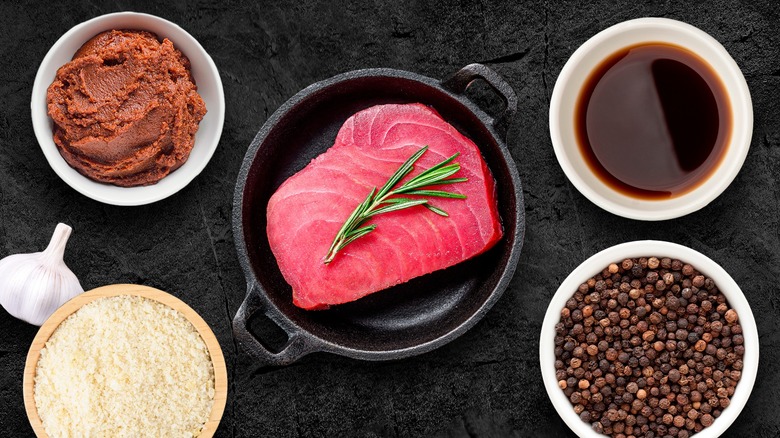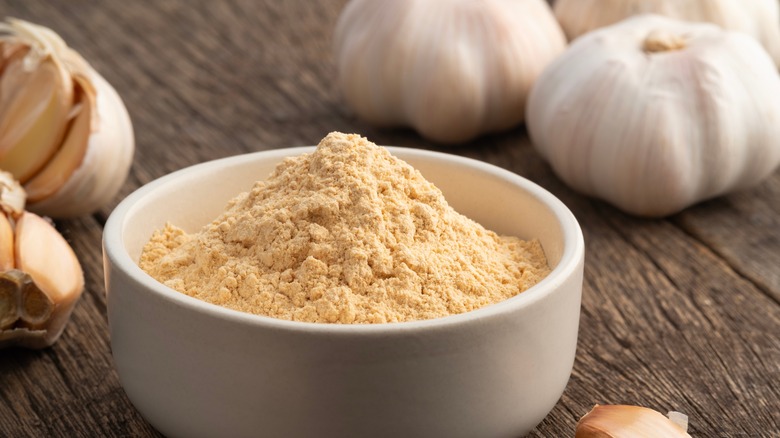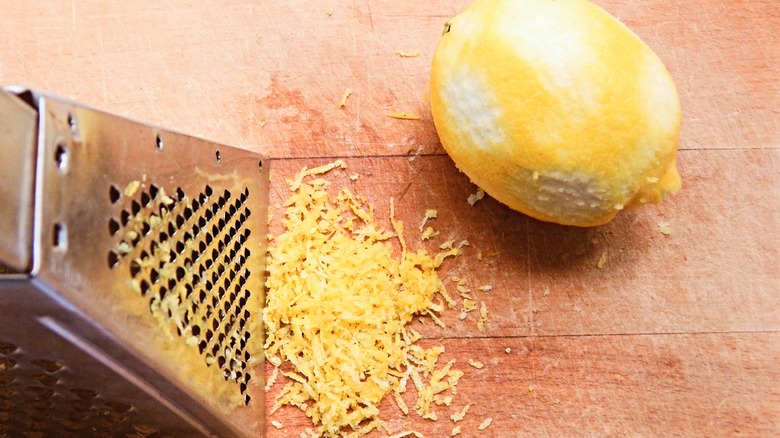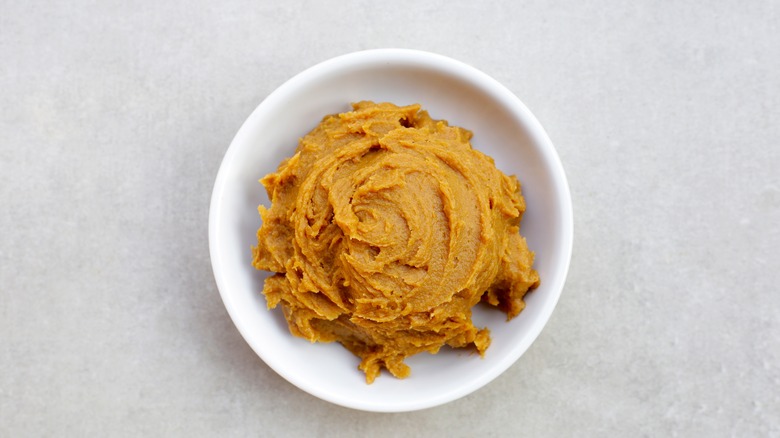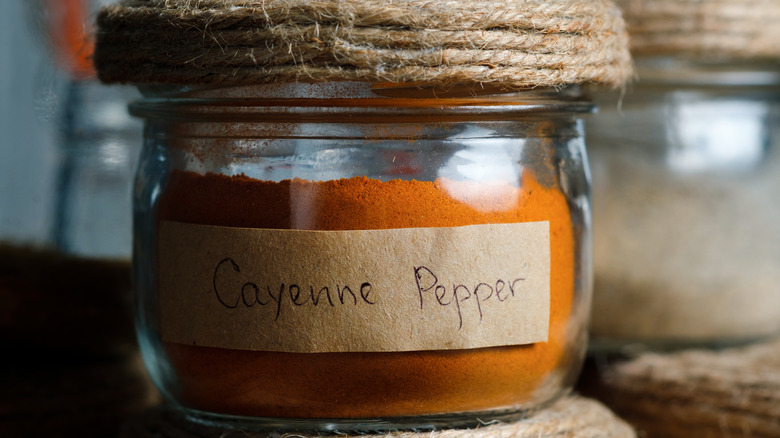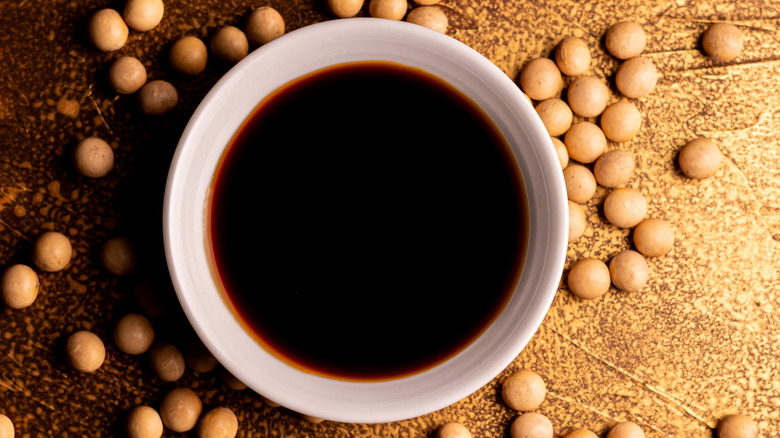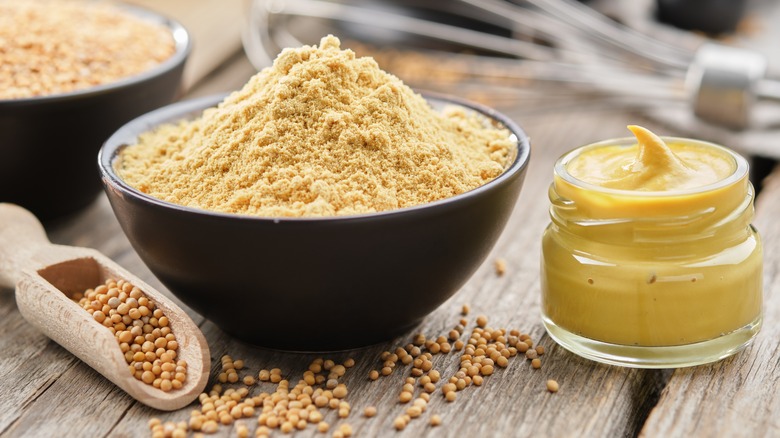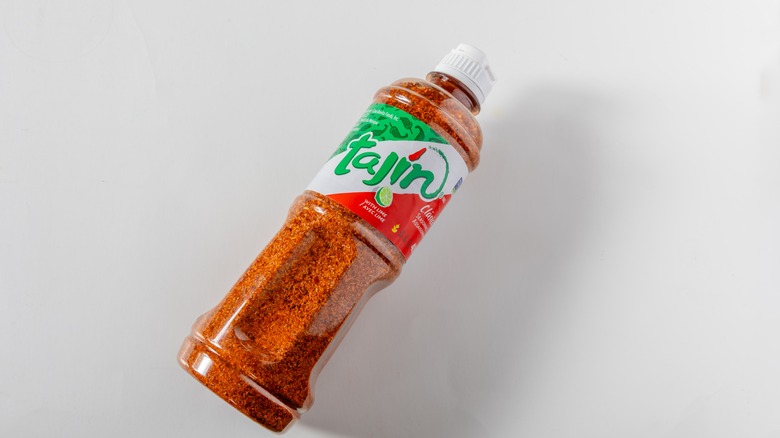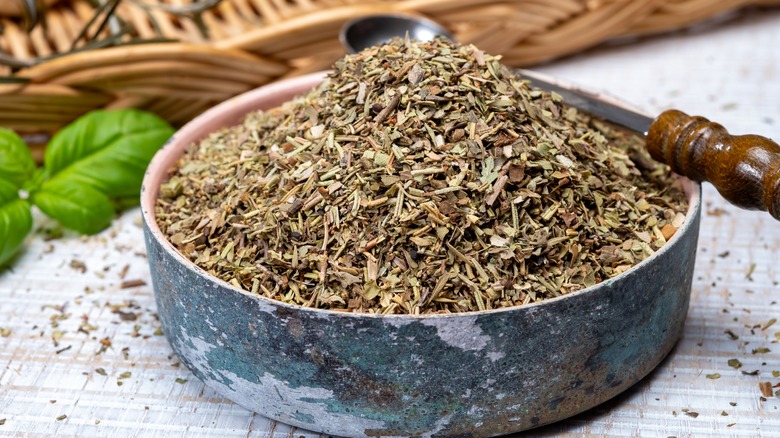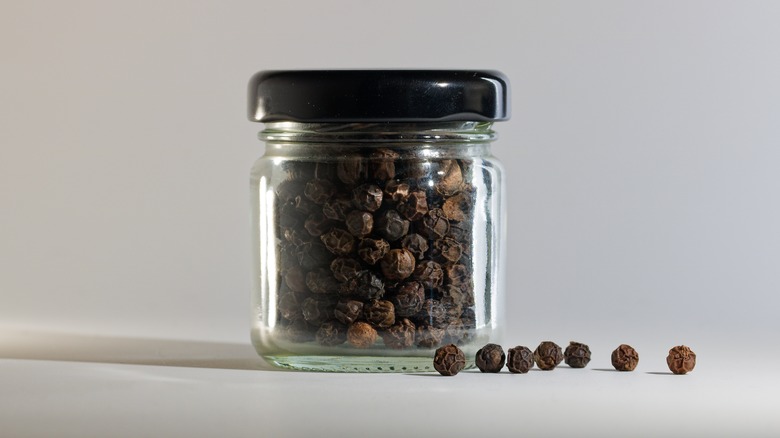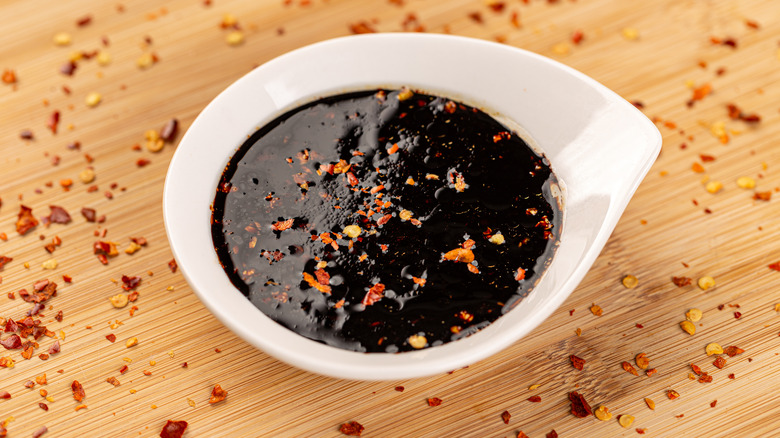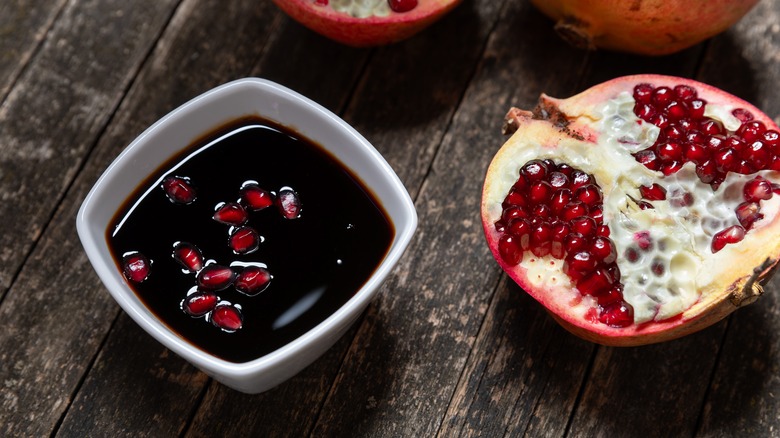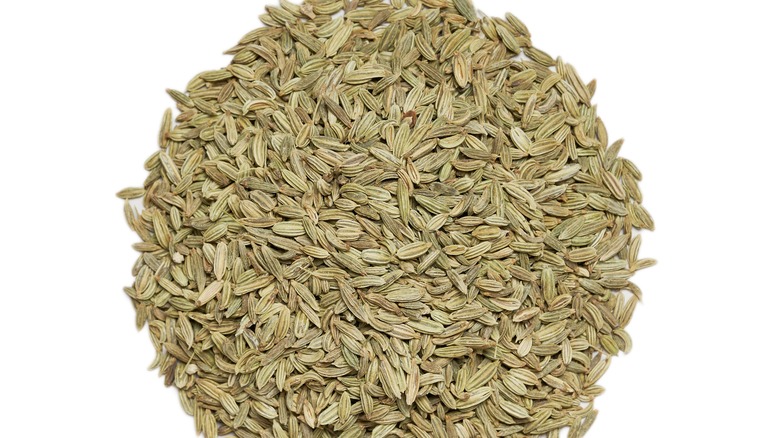12 Best Seasonings To Spice Up Your Tuna Steak
Images of a tuna dinner don't necessarily conjure up feelings of excitement or culinary excellence, but that's likely because your mind goes to canned tuna and not fresh tuna steaks. Tuna steaks are worlds apart, and it's sometimes hard to imagine that it's the same thing that's in canned tuna. This isn't to knock canned tuna, as it's delicious in its own right and provides so much versatility for quick sandwiches, salads, and more. As a lover of canned tuna, I appreciate it for what it is, but fresh tuna steaks are a whole different experience. For many home cooks, tuna steaks can be a little intimidating if you don't have much experience with them. In truth, it's quite easy to cook up a delicious tuna steak, and there's really nothing to fear.
Tuna steaks are meaty, sweet, and robust, and arguably don't resemble your usual fish texture. Because of this, tuna steaks should be treated more like beef steaks. They don't need too much to make them taste great, and they do well being seared and not cooked all the way through. Seared tuna can be achieved on a grill pan, an ordinary frying pan, or even on the grill. The secret is to get the outside nicely browned with a juicy pink center. They can be eaten as a steak or sliced up, tataki style. The best thing about tuna steaks is that they're relatively straightforward to season, and all kinds of spices and seasonings work well. As a recipe developer, I love playing around with different tastes and flavor combinations, and most of the time, I've found that simpler seasonings work best. Here are some of the best seasonings to spice up your tuna steak.
Garlic powder
One of the most effective ways to add seasonings to your tuna steak is by making a flavorful dry rub. A dry rub forms a delicate crust on the tuna once it's grilled, adding not only flavor, but a texture element too. When you're thinking of a dry rub, salt, pepper, spices, and dry herbs come to mind, but perhaps not something like garlic, as you would think that fresh garlic is not "dry" enough. But all garlic lovers know how much we love to put garlic in everything, and it is especially good with any seafood. It may be somewhat tricky to add minced garlic to your tuna steak, and there's the possibility of it burning, as garlic is quick to burn at high heat — which is a probable thing when cooking tuna steaks. Luckily, there's the invention of garlic powder that allows you to get all the glorious flavor of garlic that we love in a dry spice form.
For many home cooks, garlic powder is a no-brainer. However, some people think of garlic powder as a cop-out and think that it can never match the fresh ingredients. Garlic powder doesn't deserve its bad reputation, and it has many useful applications in different dishes. Garlic powder isn't some artificial flavor; it's real garlic cloves that have been dried up and ground, so it's true that in powder form, it may lose some of the pungency of fresh garlic. However, it still has a pleasant garlic kick that would complement a tuna steak really well. Its dry application allows you to include it in your dry herb with other seasonings of your choice without having to bother with peeling, chopping, and potentially burning fresh garlic.
Lemon zest
Lemon and seafood are perhaps one of the most natural pairings one can make in the kitchen. A squeeze of lemon juice is always going to enhance your seafood, give it a burst of brightness, and temper unwanted fishy aromas. There's almost no seafood that wouldn't benefit from some lemon juice, from grilled fish, squid, shrimp, lobster, crab, scallops, clams, oysters, and more. Tuna is no different. Although tuna is on the meatier side of seafood, it still goes great with the burst of freshness that lemon gives it. While lemon juice provides that hit of acid that lifts everything, it's the skin of the lemon that has a concentrated lemon flavor that doesn't always come through in the juice. This is why I love to use lemon zest, in addition to the juice, on my tuna steaks. Lemon zest is packed full of bright lemon flavor, taking tuna steaks to the next level.
Use a zester or the fine side of your cheese grater to zest a lemon and pat this zest onto your tuna steaks, along with the other seasonings of your choice. You can also throw the zest into your pan while cooking so that it flavors the oil or butter that's coating your fish.
Miso paste
There are few ingredients that offer a full-bodied flavor completely on their own, like miso paste. Miso paste hits every note, from salty to slightly sweet, umami, and even a hint of smokiness. All these flavors bring out the natural sweetness, smokiness, and umami in your tuna steak, which makes them a match made in heaven. Simply coat your tuna steaks in a generous layer of miso paste and get cooking. If you go the route of grilling or searing your steak, the miso will caramelize and become even more tasty, creating a little crust on your tuna.
Miso paste also makes a great base for a glaze. Miso on its own doesn't miss any other seasoning, but that doesn't mean it can't get even better with some additions. If you pair it with some sesame oil and mirin, like in this baked tuna steak with sesame-miso glaze recipe, you'll have extra nuttiness and a little acid to balance all the flavors together.
Cayenne pepper
If you like a bit of heat in your food, then it's a must to add some cayenne pepper to your tuna steak. While there are numerous ways to add some chili spiciness to your food, cayenne pepper is a great balance of both flavor and heat. It's not only the ideal seasoning to spice up canned tuna, but it's just as effective on tuna steaks. Tuna has a natural sweetness and cayenne pepper makes it pop, making it even meatier.
It's mild but buildable, so you can start with less if you prefer milder heat and add more if you want to take it up a notch. The fact that it's in powder form makes it incredibly easy to add it to a dry rub or a spice blend of your choice. It works well with spices like cumin, paprika, coriander, and turmeric. It's also the perfect spice to use if you want to use just a simple seasoning with salt and pepper. Simply pat it onto your tuna steaks and cook.
Soy sauce
Tuna is one of those proteins that can go in many directions taste-wise. You can use anything from Italian herbs to Mexican spices to Japanese seasonings to cook your tuna steak. Soy sauce is an almost obvious pairing for tuna steaks (to be honest, what isn't good with soy sauce?) because it gives it all the salt it requires and an extra dose of umami for good measure.
Soy sauce is the perfect liquid to use as a marinade for your tuna, and if you give it a little time to marinate, its salty goodness will seep deeper into the flesh and season it on the inside as well as the outside. It's also possible to use soy sauce as a dipping sauce for your tuna, especially if you do something like sliced, seared tuna, tataki style. There's also the option of making a glaze with your soy sauce by mixing it with some honey and playing on the sweet and savory notes in your tuna steak. Soy sauce is so versatile that the possibilities are truly endless.
Dry mustard
Mustard is that sweet and spicy yellow sauce that we all know and love, but it also exists in a powder form, which may surprise some people. Mustard powder, or dry mustard, is made from real mustard. It's pure ground mustard seeds, and it has all the flavor of mustard in a powder form. It can be reconstituted as mustard sauce if you add water to it, but using it as a powder is often a secret weapon. It's one of the culinary tricks behind really delicious seasonings and spice rubs, and it adds a subtle kick of complexity to tuna steaks that give it a lot of flavor.
Pat some dry mustard onto your tuna steaks, along with some salt and pepper. Paprika is a good complementary spice if you're looking for one. Your steak will be delicious as is, but if you want some extra oomph, throw in a little butter and white wine in the pan, along with some more dry mustard for a rich sauce.
Tajín
One of my favorite seasonings to add to tuna steaks is Tajín. This Mexican spice, called Tajín Clásico, is made from dried chili peppers, dehydrated lime, and sea salt. The blend of chili and citrus can bring anything to life, and it works especially well on tuna steaks. The best thing about it is that it's an all-in-one seasoning, and tuna steaks are instantly transformed using only some Tajín.
As citrus goes so well with seafood, the dried lime adds the perfect amount of acid needed for the tuna, and the fruitiness of the lime gives it a more dynamic taste. The dried chili balances out that fruity acidity with some heat and a pleasant pepper flavor that brings out its meatiness. Plus, the salt in the Tajín is enough to season your fish without needing any extra salt. You can always leave some on the table in case you want even more on tuna, as it's just as tasty with no cooking as it is used as a cooking spice blend. Add it as is to your tuna steaks, or mix it into your favorite marinades. In fact, you can use it in this chili lime tuna steak recipe instead of fresh chiles and limes to make it even easier. You'll want to throw it on everything, from popcorn to dips, salads, chicken, and more.
Herbs de Provence
Taking inspiration from French cuisine, the blend of certain dried herbs can instantly elevate your tuna into an herbaceous and earthy steak. Herbs de Provence is one of my favorite French herb blends, as it combines all the woody and aromatic dried herbs needed to make a more complex and fragrant meal. This blend, which hails from the South of France, can change in composition depending on the seasonality, availability, and preference of the maker but often includes oregano, thyme, rosemary, marjoram, mint, and tarragon. These herbs work really well with meat, fish, and poultry, so they are very suitable for tuna steak.
You can usually buy a mix of herbs de Provence from mainstream grocery stores, or you can make your own blend using a mix of dried herbs. Shake some onto your tuna steaks, along with salt and whatever spices you want to use. Adding some butter to the pan (as the French would) brings all the flavors together into a rich and well-balanced dish.
Peppercorns
You don't have to look for any fancy spices and seasonings to make a delicious tuna steak. Sometimes, it's the simplest of things that can be the best. Pepper may seem like too rudimentary a spice to include in a list of best seasonings for a tuna steak, but the use of peppercorns with tuna is too delicious to ignore. Tuna has a pleasant sweetness that can be complemented with something strong, and pepper adds all the zing to bring out the best of it.
This peppercorn-crusted tuna steak recipe isn't made with your average pepper shaker. For this, you'll need whole peppercorns that you crush yourself by hand with a pestle and mortar or spice grinder. Keep them chunky, and don't grind them too fine until they're a powder. The peppercorns add a crunchy crust to your tuna on top of the delightful fruity pepper hit they give the dish. But so that you get enough crunchiness without numbing your tongue with too much pepper, it's a good idea to mix your peppercorns with some sesame seeds. The added nuttiness will mellow out the fiery peppercorns and give the crust the same texture effect.
Teriyaki sauce
So many Japanese flavors work magically with tuna steak that it's always a good idea to look to Japanese condiments and seasonings for ideas. Teriyaki sauce is known for being delicious with chicken, beef, and more, so it's definitely the right choice for tuna steaks, too. It's the Japanese version of barbecue sauce, so you already know that it's going to add so much sweet, savory, and smoky flavor to your tuna steak. Using a barbecue-like sauce makes perfect sense for such a meaty fish like tuna.
Teriyaki sauce can be used as both a marinade and cooking sauce, so to maximize the flavor, let your tuna steaks marinate in it for about an hour. Then, when cooking your steaks, slather even more teriyaki on them and watch the sauce caramelize and create a sweet crust on your fish. Be careful not to leave it on high heat for too long, as the sugar content in the sauce can burn. Finish it off with some sesame seeds, chili flakes, or chopped scallions.
Pomegranate molasses
If you're not familiar with Middle Eastern cooking, you may not have used or come across pomegranate molasses before. This tangy condiment is a reduction of pomegranate juice, making it an interesting combination of both sweet and sour. It's deeply ruby red in color and adds a beautiful dark red tinge to anything it's added to. While it's considered a type of syrup, pomegranate molasses is used in many savory dishes in Middle Eastern cuisine and is poured over braises, stews, grilled meats, and sausages and incorporated into salad dressings. It's a unique ingredient to use with tuna steak, but unsurprisingly, it works wonderfully, adding a sophisticated sweet and sour element that really brightens up tuna steak.
As pomegranate molasses is thick and syrupy, it naturally makes a glaze when you use it as a meat marinade. Mix it up with some olive oil, salt, and pepper, and coat it all over your tuna steaks. This works best when making seared tuna as the quick cooking time means the sugar molasses won't have a chance to burn — but, it's good to watch out for burning regardless.
Fennel seeds
There are various spices that live in most people's pantries year-round. Spices like cinnamon, paprika, cumin, ginger, and turmeric are common heavy hitters that, depending on your culture, you'll be more confident and familiar with using. Fennel seeds are one of those spices that a lot of people don't know how to cook with, which is a shame as it's a highly underrated spice. It's somewhat polarizing as people either love or hate its aniseed flavor. But this is what makes it such a special addition to tuna steaks. The sweetness in the fennel seeds match the sweet tuna meat, and they add a woody smokiness that few other spices could bring out on their own.
If you don't enjoy it, then I recommend mixing it into a larger spice blend so that the aniseed flavor doesn't dominate. Take your cue from this four-spice blend that Jamie Oliver uses to season tuna steaks. He mixes fennel seeds with coriander seeds, salt, and pepper to make a spice rub that he crushes to form a coarse blend, and then coats the fish with it before searing.
